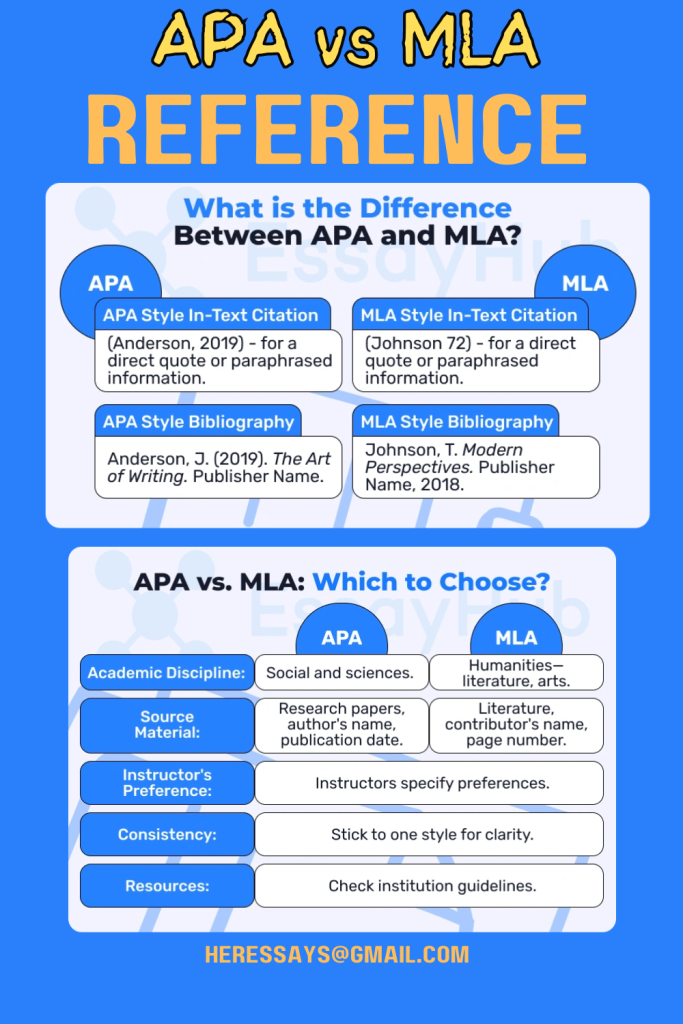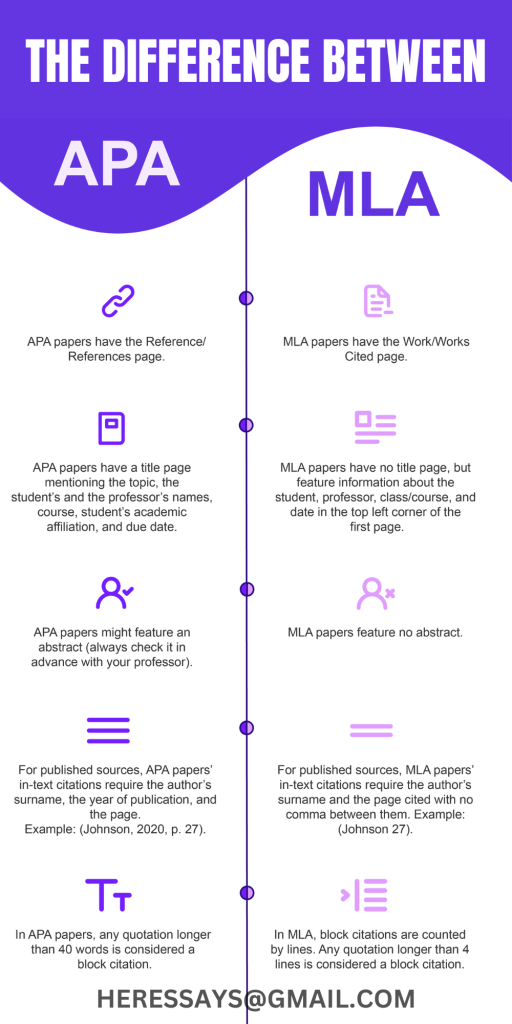When it comes to academic writing, two of the most commonly used citation styles are APA (American Psychological Association) and MLA (Modern Language Association). Although both serve the purpose of citing sources in research papers and essays, they are designed for different academic disciplines and have distinct formatting rules. This article explores the key differences between APA and MLA citation styles, helping students and researchers choose the appropriate format for their work.

Purpose and Discipline
The first major difference between APA and MLA citation styles lies in their intended use across different academic disciplines. APA style is primarily used in the social and behavioral sciences, such as psychology, sociology, and education. Its focus on publication dates and authorship reflects the importance of recent research and the credibility of sources in these fields.
On the other hand, MLA style is predominantly used in the humanities, including literature, history, and the arts. MLA emphasizes the author’s contribution to the work and the page number, which is vital for referencing specific sections of literary texts.
Summary of Disciplines:
- APA: Social Sciences, Education, Psychology
- MLA: Humanities, Literature, History, Arts
Title of the Citation Page
One of the easiest ways to distinguish between APA and MLA styles is by looking at the title of the citation page. In APA style, the bibliography is titled “References.” In MLA style, it is called “Works Cited.” Both titles are centered at the top of the page, and the entries are double-spaced, but the terminology is a clear indicator of the citation style being used.
Example:
- APA: References
- MLA: Works Cited
Author Name Format
The formatting of author names in citations also varies between APA and MLA styles. In APA style, the author’s last name is followed by their first and middle initials. This format emphasizes brevity and the use of initials is common in scientific writing to avoid gender bias and to maintain consistency.
APA Example:
- Henry, J.
In contrast, MLA style spells out the author’s full first name, reflecting the tradition of humanities scholarship, where the identity and background of the author are often considered important.
MLA Example:
- Henry, John
For multiple authors, the formats diverge further. In APA, two authors are separated by an ampersand (&), while in MLA, the word “and” is used. For works with three or more authors, APA lists all authors up to 20, using commas and an ampersand before the final author. MLA, however, lists only the first author followed by “et al.”
Examples for Two Authors:
- APA: Gillespie, P. H., & Lerner, N.
- MLA: Gillespie, Paula, and Neal Lerner
Examples for Three or More Authors:
- APA: Gillespie, P. H., Corn, D. P., Son, C. R., Barry, A. B., Harlow, T., & Beck, J.
- MLA: Gillespie, Paula, et al.
Title Capitalization
Another significant difference between the two citation styles is in the capitalization of titles. APA style uses sentence case for titles, meaning only the first word of the title and any proper nouns are capitalized. This approach aligns with the scientific tradition of minimalism and neutrality.

APA Example:
- Gleason, J. (2010). Chaos: a look at the stars. RedRiver.
MLA style, on the other hand, employs title case, where all major words in the title are capitalized, reflecting the more formal and traditional approach of the humanities.
MLA Example:
- Gleason, Jeff. Chaos: A Look at the Stars. RedRiver, 2010.
In-Text Citations
In-text citations in APA and MLA formats also differ in their presentation. APA in-text citations include the author’s last name, the publication year, and the page number (if applicable). This method is designed to emphasize the currency of the research.
APA Example:
- (Ghilani, 2017, p. 83)
In MLA style, the in-text citation includes only the author’s last name and the page number, without the publication year. This approach reflects the humanities’ focus on the text and its content rather than the publication date.
MLA Example:
- (Ghilani 83)
Source Page Layout
The layout of the source page in APA and MLA styles shows notable differences. In APA, the publication date is placed immediately after the author’s name, highlighting the importance of the timing of the research.
APA Example:
- Mounier-Kuhn, P. (2012). Computer science in French universities: Early entrants and latecomers. Information & Culture: A Journal of History.
In MLA, the publication date is typically placed at the end of the citation, following the publisher and reflecting the less time-sensitive nature of research in the humanities.
MLA Example:
- Mounier-Kuhn, Pierre. “Computer Science in French Universities: Early Entrants and Latecomers.” Information & Culture: A Journal of History, vol. 47, no. 4, 2012, pp. 374-402.
Use of URLs and DOIs
When citing online sources, both APA and MLA styles include URLs and DOIs, but they differ in punctuation. APA style does not place a period after a URL or DOI, aligning with its focus on brevity and clarity.
APA Example:
- https://doi.org/10.7560/IC47402
MLA style, however, adds a period at the end of the URL or DOI, consistent with its more traditional approach to punctuation.
MLA Example:
- https://doi.org/10.7560/IC47402.
Title Pages and Headers
APA style typically requires a title page that includes the title of the paper, the author’s name, institutional affiliation, course details, instructor’s name, and the date. This format reflects the structured and formal nature of scientific writing.
APA Title Page Example:
- Title of the Paper
- Student Name
- Institutional Affiliation
In contrast, MLA style usually does not require a separate title page. Instead, the student’s name, instructor’s name, course title, and date are placed on the first page above the title of the paper.
MLA Header Example:
- Student Name
- Instructor’s Name
- Course Title
- Due Date
Conclusion
Understanding the differences between APA and MLA citation styles is crucial for students and researchers working across different academic disciplines. APA’s focus on date and brevity suits the social sciences, where recent research is paramount. In contrast, MLA’s emphasis on detailed author names and literary titles reflects the traditions of the humanities. By choosing the correct citation style, writers can ensure that their work meets the expectations of their academic field and presents their research in the most effective way possible.
References
Betts, J. (2024). Difference Between MLA and APA Citation Pages. Bibliography.com. Retrieved from https://www.bibliography.com/learn/difference-between-mla-and-apa-citation-pages/
Spartanburg Community College Library. (2024). Differences Between MLA and APA Format. Spartanburg Community College Library. Retrieved from https://libguides.sccsc.edu/mlaorapa
McCombes, S. (2024, January 17). APA vs MLA | The Key Differences in Format & Citation. Scribbr. Retrieved August 29, 2024, from https://www.scribbr.com/citing-sources/apa-vs-mla/